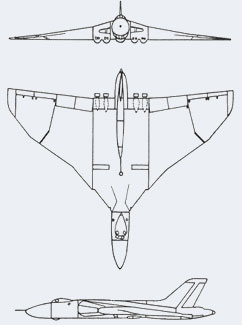Avro Vulcan
 The Avro Vulcan was a British delta-wing subsonic bomber, operated by the Royal Air Force from 1953 until 1984. The Vulcan was part of the RAF's V bomber force, which fulfilled the role of nuclear deterrence against the Soviet Union during the Cold War.
The Avro Vulcan was a British delta-wing subsonic bomber, operated by the Royal Air Force from 1953 until 1984. The Vulcan was part of the RAF's V bomber force, which fulfilled the role of nuclear deterrence against the Soviet Union during the Cold War. Avro began scale prototype testing in 1948 with the single-seater Type 707, and despite the crash of the first prototype on 30 September 1949 work continued.
Avro began scale prototype testing in 1948 with the single-seater Type 707, and despite the crash of the first prototype on 30 September 1949 work continued.
In September 1956, the RAF received its first Vulcan B.1, XA897, which immediately went on a fly-the-flag mission to New Zealand. On 1 October, while approaching London Airport to complete the tour, XA897 crashed short of the runway in bad weather conditions.
The B.2 variant was first tested in 1957 and entered service in 1960. It had a larger wing and better performance than the B.1 and had a distinctive kink in its delta wing to reduce turbulence. In all, 134 Vulcans were produced, the last being delivered to the RAF in January 1965. The last miliatry-operational Vulcan squadron was disbanded in March 1984.
Although the primary weapon for the Vulcan was nuclear, Vulcans could carry up to 21 x 1000 lb (454 kg) bombs in a secondary role.  The only combat missions involving the Vulcan took place in the 1982 Falklands War with Argentina, when a number of Vulcans flew the 3,380 nautical miles (6300 km) from Ascension Island to Stanley to bomb the occupied airfield there with conventional bombs in Operation Black Buck. By this date the number of Victors available for air-to-air refueling was extremely limited, so some Vulcan aircraft were adapted in just 50 days to fulfil that role during the conflict. Five Vulcans were chosen for the operation: their bomb bays were modified, the fuel systems replaced and the electronics updated. The first bombing mission was on April 30–May 1 and there were five further bombing missions. At the time these missions held the record for the world's longest distance raids.
The only combat missions involving the Vulcan took place in the 1982 Falklands War with Argentina, when a number of Vulcans flew the 3,380 nautical miles (6300 km) from Ascension Island to Stanley to bomb the occupied airfield there with conventional bombs in Operation Black Buck. By this date the number of Victors available for air-to-air refueling was extremely limited, so some Vulcan aircraft were adapted in just 50 days to fulfil that role during the conflict. Five Vulcans were chosen for the operation: their bomb bays were modified, the fuel systems replaced and the electronics updated. The first bombing mission was on April 30–May 1 and there were five further bombing missions. At the time these missions held the record for the world's longest distance raids.  Specifications (Vulcan B.2)
Specifications (Vulcan B.2)
General characteristics
Crew: 5; Pilot, Co-Pilot, Navigator Plotter, Navigator Radar and Air Electronics Officer
Length: 99 ft 11 in (30.45 m)
Wingspan: 111 ft 0 in (33.83 m)
Height: 27 ft 2 in (8.28 m)
Wing area: 3965 ft² (368.4 m²)
Empty weight: lb (kg)
Loaded weight: 199,585 lb (90,530 kg)
Useful load: 21,000 lb (9,550 kg)
Maximum Take-Off Weight: 204,000 lb (92,500 kg)
Powerplant:
4× Rolls Royce Olympus 201/301 turbojets, 17,000 lbf/20,000 lbf (76 kN/355.9 kN) each
Performance:
Maximum speed: 645 mph (1,040 km/h)
Cruise speed: 625 mph (1,005 km/h)
Range: 2,300 mi (3,700 km)
Service ceiling: 62,300 ft (19,000 m)
Wing loading: 50 lb/ft² (246 kg/m²)
Armament:
1x Blue Steel cruise missile semi-recessed in the fuselage or 1x Yellow Sun Mk.2 nuclear bomb or 21x 1,000 lb (450 kg) bombs. Aircraft participating in the Falklands war also carried 2x AGM-45 Shrike anti-radiation missiles under the wings.
Links:
http://www.avrovulcan.org.uk/
http://www.raf.mod.uk/rafwaddington/vulcan.html
Vulcan to the Sky
(Adapted from http://www.wikipedia.org/)



0 Comments:
Post a Comment
<< Home